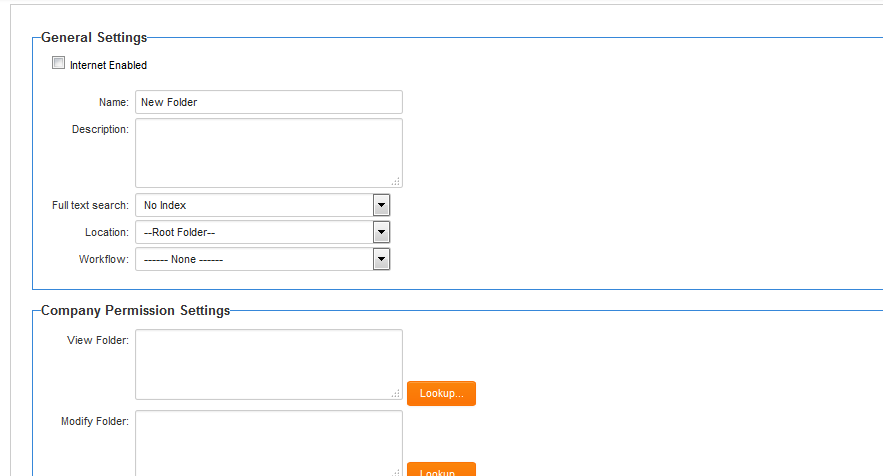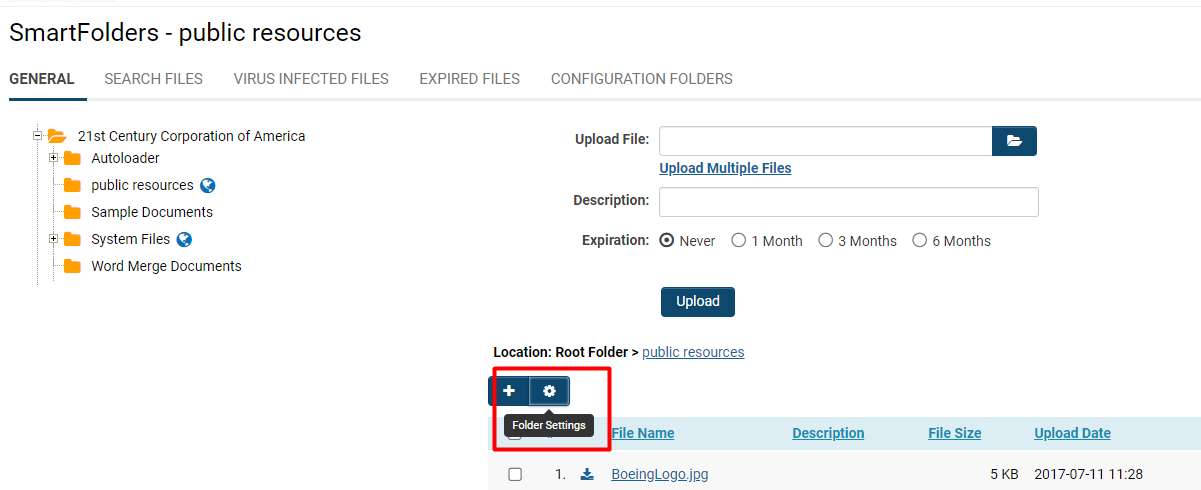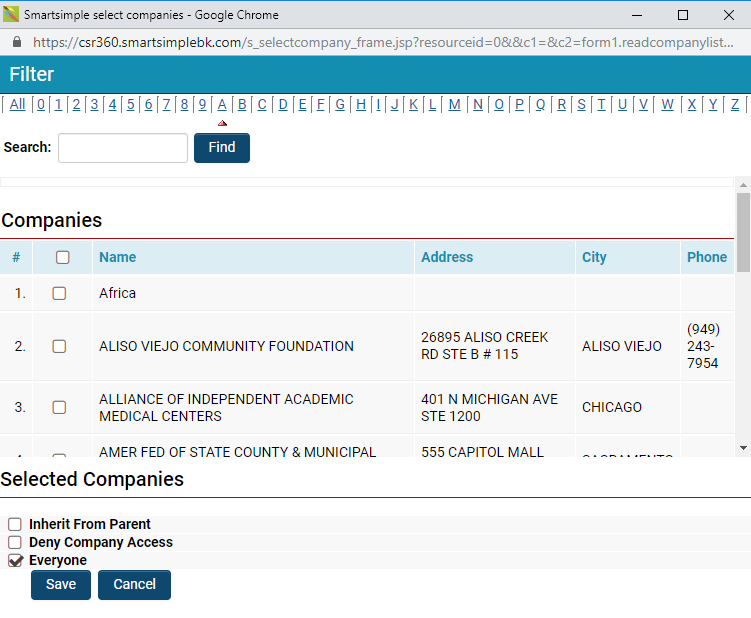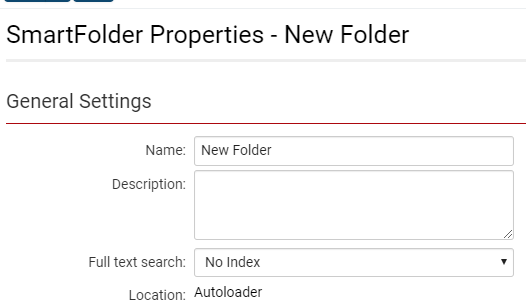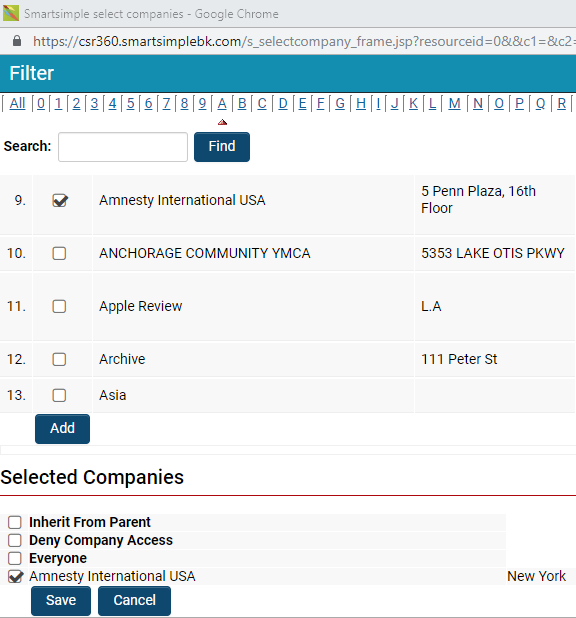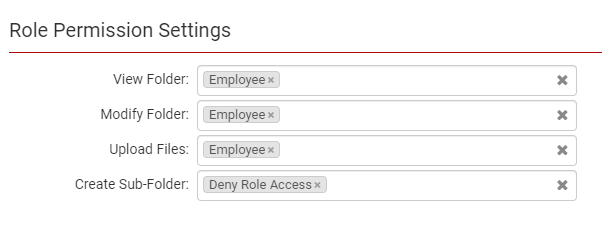SmartFolders Overview
Contents
Overview
SmartFolders provide online storage for files, in a secure central location, that is accessible from any computer with Internet access.
SmartFolders Features
| Feature | Functions |
|
Permissioned Access |
|
| File Check Out/Check In |
|
| Workflow Driven |
|
| Internet Enabled |
|
| External Notes |
|
| Email File |
|
| New Folder and File Flag |
|
| Folder Size Limitation |
|
Configuration — Essentials
Setting Up SmartFolders
To access your SmartFolders, click the 9-square menu icon on the top right of your page.
Under the heading Tools, select SmartFolders to display your SmartFolders window.
- Initially, there will be no folders or files available.
Within your SmartFolders window, select New to set up a new SmartFolder.
The New Folder window is displayed.
Folder Settings
There are two views to a folder:
- Folder Setting View: This view displays the security and other settings for the folder. This is the view you see when you first create a folder.
- Folder Content View: This view displays the files you have uploaded to the folder. When you open an existing folder, the content view is used. If you need to see or alter the folder setting, select the Folder Settings button.
Folder Content and Properties
Each folder has the following properties:
| Property | Description |
| Internet enabled | Displays a web address or URL that can be used to navigate the folder on the Internet. Anyone can navigate to this URL to see the folder contents. If you use this feature, the folder must be permissioned for Everyone access. |
| Name | The name you wish to give the folder. |
| Description | A longer description as to the purpose of the folder. |
| Full Text Search | Option to index all of the folder contents, including any sub-folders. |
| Location | The position in the folder hierarchy where the folder should be displayed. You can change the parent folder and move the folder to a new location in the hierarchy. |
| Workflow | Associate this folder with a workflow process that will automatically start whenever a new file is added to the folder. |
| Company Permission Settings - View Folder | List of organizations that are allowed to read the contents of this folder. |
| Company Permission Settings - Modify Folder |
List of organizations that are allowed to modify folder settings. |
| Role Permission Settings - View Folder |
List of roles that are allowed to read the contents of the folder. |
| Role Permission Settings - Modify Folder | List of roles that are allowed to modify folder settings. |
| Role Permission Settings - Upload Files | List of roles that are allowed to upload files into the folder. |
| Role Permission Settings - Create Sub-folder | List of roles that are allowed to create sub-folders under the current folder. |
- The roles available to any user are dependent on the permissions associated with their role.
- If you do not set permission to a folder at the root, then as the owner you will be the only person who can access the folder.
Configuration — Advanced
Folder Security
Folders created within an existing folder "inherit" the security of the higher-level (parent) folder. If you can change the security of the parent folder at any level, it will also be changed for associated lower-level folders.
In this example, you will explore the General Settings and Security Permissions of of SmartFolders by enabling Everyone with access to view a folder.
1. Select an existing folder to open its contents and details.
2. Go to the Folder Settings by selecting the gear icon.
3. Under Company Permission Settings - View Folder, select the binoculars icon.
4. A window of the organizations list will appear. ¶
5. Check Everyone.
6. Click the Save button.
You may repeat this process for other Security Settings under Company Permission Settings or Role Permission Settings. You may alter the Security of a folder at any time by going back and selecting different permission accessibilities.
Following the previous example, we will next add a sub-folder but restrict access to a specific external company while allowing everyone internally to access the folder by referencing the internal Employee role.
1. By selecting the + icon on a folder page, we can create a sub-folder.
2. A new folder window is displayed. In this example, the parent folder (Location) is set to "Autoloader."
3. Under Company Permissions Settings - View Folder, select the binocular icon.
4. In the pop-up list of organizations, check the external company you want to allow viewing access to. In this example, it is "Amnesty International USA."
- Be sure to click the Add button so that the selected company will show up at the bottom, under Selected Companies.
- Be sure to deselect the other bottom choices of Inherit From Parent, Deny Company Access, and Everyone.
5. Repeat steps 3 and 4 for Company Permissions Settings - Modify Folder.
6. Under Role Permissions Settings, complete the following details:
7. Click the Save button.
Now the access for the sub-folder you have created is as follows:
- The company access to view and modify the folder is set to one external company. Anyone from this company can see the contents and add files to this folder.
- The role access is set to the Employee role. Anyone in any branch of the internal root organization can see the contents, modify, and add files to this folder.
- The role access is set to Deny Role Access for Create Sub-Folder. This means no one but the Global User Administrator is able to create a sub-folder from this folder.
Depending on the instance, it may make sense to use company restrictions to establish security; in other situations, roles might be more effective.

